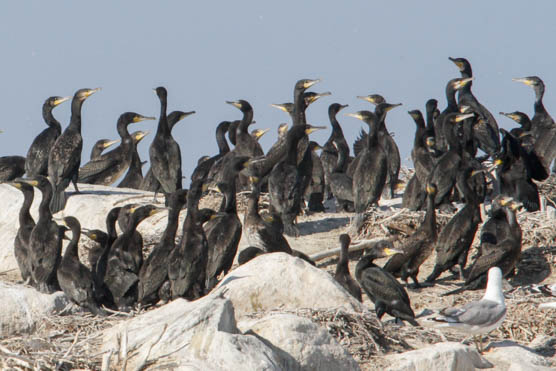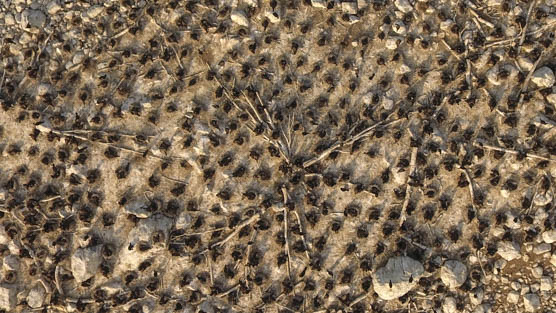Press release 2019-08-13 at 8:26
Approximately 25,700 cormorant nests were counted in Finnish sea areas in the summer of 2019. This represents a decrease of 4%, or 1,000 nests, in comparison to the previous year. With the cormorant nest population already nearing its natural peak, hunting by the white-tailed eagle is also reducing the cormorant population.

Cormorants on a nesting islet Image: Antti J. Lind.
The cormorant population grew rapidly from 10 pairs in 1996 to over 20,000 pairs in 2014. The number of nests fell by a few per cent in 2010 and 2012. In those years, the number of nests throughout the Baltic Sea region decreased due to severe weather conditions in wintering areas.
In Finland, hunting by white-tailed eagles has continued to increase during the 2010s and reduced breeding success even in some of the large nesting colonies. As a result, the number of 3-year-old cormorants of nesting age that return to their area of birth is relatively lower.
One-third of cormorant nests were located in the Gulf of Finland and one-quarter in the Archipelago Sea and Bothnian Sea respectively. The share of the population in Kvarken decreased to 15% and to 3% in the Bothnian Bay. A storm at the end of May destroyed some of the nests in the Bothnian Bay.
The number of nests in Kvarken and the Bothnian Sea has fluctuated for the past four summers. This is due to the disturbance of nests, both legally and illegally. The population in the Bothnian Sea increased by 1,000 nests while the population in Kvarken decreased by more than 1,500 nests from the previous year.
All in all, the cormorant population in the Gulf of Bothnia decreased by 7% to approximately 11,140 nests, with 6,540 located in the Bothnian Sea, 3,800 in Kvarken and 800 in the Bothnian Bay. The population in the Gulf of Finland fell by 3% to approximately 8,700 nests. The population in the Archipelago Sea remained at last year’s level and totalled 5,850 nests.
The largest colonies are in Virolahti and Nykarleby
A total of 47 cormorant colonies were found in Finland, located on 82 islets over an area totalling approximately 76 hectares. The number of colonies was two less than the average for the last five years. Nearly half of the colonies nested in bird conservation areas.
More than half of the population nested in the 10 largest colonies. Colonies of more than 1,000 nests were located in Rauma (2,080 nests), Kirkkonummi (1,793), Turku (1,766), Mustasaari (1,710), Uusikaupunki (1,670), Eurajoki (1,560), Pori (1,246), Virolahti (1,148), on the border of Kustavi and Pargas (1,055) and in Nykarleby (1 051).

Cormorant colony in Satakunta Image: Antti J. Lind.
At the municipal level, the strongest growth was observed in Rauma, where the population nearly tripled in size. In contrast to recent years, no nests were found in Kotka or Vaasa and the populations also decreased significantly (approximately 30%) in Porvoo, Uusikaupunki and Eurajoki. The only colony in Uusikaupunki decreased by more than 700 nests, and a maximum of 20 concurrent sightings of white-tailed eagles hunting were recorded in the colony.
Seven colonies from the previous year were abandoned and five new colonies were observed: in Helsinki, Sauvo, Maalahti and Vöyri. Several hundred destroyed nests were found in Hamina, the Luvia district in Eurajoki, Maalahti and Nykarleby. Other suspected destroyed nests were found at least in Porvoo and the Iniö district of Pargas.
Future prospects for population growth
Growth of the Finnish cormorant population has slowed significantly. The nesting cormorant population is close to its natural peak and noticeable growth is no longer expected. The populations in sea areas have typically reached their natural peak some 10 years after the first nesting. A similar situation has been observed in other parts of the Baltic Sea and in Holland. Winter conditions in the Baltic Sea and hunting by the white-tailed eagle are significant factors affecting changes in population size.
Common guillemot benefits from cormorant nests
In 2019, nesting common guillemot were found on two cormorant islets in the Kymenlaakso region. Due to its small population size (80–130 pairs), this species is classified as endangered (EN) in Finland and rarely establishes new colonies. A small common guillemot colony settled on a cormorant islet in Loviisa a few years ago. Guillemots and cormorants often co-exist in, for example, the North Sea and Arctic Ocean.
Number of cormorant nests 2010–2019
Percentage increase in the cormorant population 2010–2019
Cormorant monitoring is conducted to collect basic information about the ecology and spreading of the species in Finland. The cormorant is protected in Finland throughout the year under the Nature Conservation Act, and it is not on the EU's list of huntable species.
Number of cormorant nests by region in 2019
Further information
Pekka Rusanen, Researcher, Finnish Environment Institute SYKE,
tel. +358 400 148 691, firstname.lastname@ymparisto.fi
Markku Mikkola-Roos, Senior Researcher, Finnish Environment Institute SYKE,
tel. +358 400 148 685, firstname.lastname@ymparisto.fi